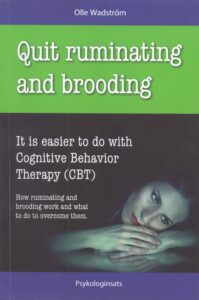Albert had his attention directed towards the rabbit when he was frightened. The rabbit was removed and was not visible to him when he calmed down again. Fear (anxiety) and the presence of rabbit were connected, and calm was connected to the absence of rabbit.
An object or an event may acquire frightening characteristics if it disappears from you when you are frightened and is not with you when you are calming down. What happens is called conditioning, and the thing that acquires the automatically frightening characteristic is called a conditioned stimulus.
The fact that it was other people who removed the rabbit from Albert, and that he himself did not escape is of no importance. Only the fact that the rabbit was with Albert when he had anxiety, but was not there when he was calmed made him frightened of the rabbit. In the same way that Albert became frightened of his favorite rabbit, it is possible to become frightened by natural occurrences like standing in line, riding a bus, going to the movies, or the heart skipping a beat.
When you ruminate, you escape your discomforting thoughts with the help of your comforting thoughts. This leads to feelings of increased discomfort from the discomforting thoughts. As soon as conditioning has occurred, the discomforting thoughts automatically trigger discomfort. They have become conditioned stimuli for unpleasantness.
Escape, avoidances, and other safety-behaviors increase the sensitivity for the things that you escape or insure yourself against. In attempting to disprove, avoid or distract yourself from discomforting thoughts with comforting thoughts, you make them more frightening, painful and unpleasant.
When discomforting thoughts become increasingly discomforting through conditioning, it feels even more pressing to thwart them with more comforting thoughts. This makes discomforting thoughts even more discomforting, and may result in a vicious circle.
Comforting thoughts make you feel more discomfort in the face of discomforting thoughts through conditioning. This makes it feel even more necessary to use comforting thoughts to thwart the increased discomfort. In the long term, comforting thoughts make you feel worse from your discomforting thoughts, and even lead to more discomforting thoughts.
This is an exerpt from the book Quit Ruminating and Brooding by Olle Wadström. Comments and discussions are encouraged.
The book is available in two similar versions. Please choose the green and black version. AuthorHouse (the white version) keep my legally earned royalty to themselves.

 Why is it so hard to make the hurtful thoughts disappear, even though you really want them to? What is the reason that ruminations go on and on despite our efforts to quit? What mechanism makes it persist even though we do “everything” to rid ourselves of it? Most of us have, at one point or another during our lives, wanted to end our ruminations instantly.
Why is it so hard to make the hurtful thoughts disappear, even though you really want them to? What is the reason that ruminations go on and on despite our efforts to quit? What mechanism makes it persist even though we do “everything” to rid ourselves of it? Most of us have, at one point or another during our lives, wanted to end our ruminations instantly.